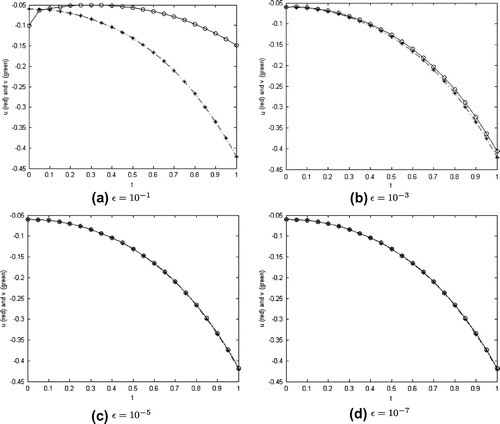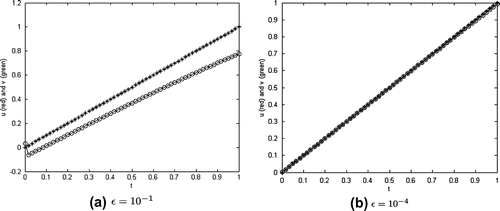 ?Mathematical formulae have been encoded as MathML and are displayed in this HTML version using MathJax in order to improve their display. Uncheck the box to turn MathJax off. This feature requires Javascript. Click on a formula to zoom.
?Mathematical formulae have been encoded as MathML and are displayed in this HTML version using MathJax in order to improve their display. Uncheck the box to turn MathJax off. This feature requires Javascript. Click on a formula to zoom.Abstract
In this paper, we investigate the Cauchy problem for both linear and semi-linear elliptic equations. In general, the equations have the form
where is a positive-definite, self-adjoint operator with compact inverse. As we know, these problems are well known to be ill-posed. On account of the orthonormal eigenbasis and the corresponding eigenvalues related to the operator, the method of separation of variables is used to give the solution in series representation. Thereby, we propose a modified method and show error estimations in many accepted cases. For illustration, two numerical examples, a modified Helmholtz equation and an elliptic sine-Gordon equation, are constructed to demonstrate the feasibility and efficiency of the proposed method.
1. Introduction
In practice, the Cauchy problem of elliptic equation arises in many applications. For example, in optoelectronics, the determination of a radiation field surrounding a source of radiation (e.g. a light emitting diode) is a frequently occurring problem. As a rule, experimental determination of the whole radiation field is not possible. Practically, we are able to measure the electromagnetic field only on some subset of physical space (e.g. on some surfaces). So, the problem arises how to reconstruct the radiation field from such experimental data (see for instance [Citation1]). Other applications are in inverse obstacle problems (cf. [Citation2]), in connection with inclusion detection by electrical impedance tomography when only one pair of boundary current and voltage is used for probing the examined body.[Citation3]
Let be a real Hilbert space, and let
be a positive-definite, self-adjoint operator with compact inverse on
. In this paper, we consider the problem of finding a function
satisfying
(1)
(1)
associated with the initial conditions(2)
(2)
where is a mapping from
,
and
are the exact data in
. Physically, the exact data can only be measured, there will be measurement errors and we, thus, would have as data some functions
and
in
for which
(3)
(3)
where the constant represents a bound on the measurement error and
denotes the
norm.
Since Hadamard [Citation4], it is well known that the Cauchy problem (Equation1(1)
(1) ) and (Equation2
(2)
(2) ) is severely ill-posed: although it has at most one solution, it may have none, and even if a solution exists, it does not depend continuously on the data
in any reasonable topology. Therefore, regularization is needed to stabilize the problem. In recent years, many special regularization methods for the homogeneous and nonhomogeneous Cauchy problem of elliptic equation have been proposed, such as Backus–Gilbert algorithm, [Citation5] the method of wavelets,[Citation6] quasi-reversibility method,[Citation7] truncation method,[Citation8] nonlocal boundary value method,[Citation9] some other methods [Citation10–Citation13], etc.
Although we have many works on the linear homogeneous case of Cauchy problem for elliptic equations, regularization theory and numerical simulation for nonlinear elliptic equations are still limited. Especially, the nonlinear cases for elliptic equations appear in many real applications. For example, let us see a simple one inferred by taking and
in the problem (Equation1
(1)
(1) ) and (Equation2
(2)
(2) ). In particular, it is given by
(4)
(4)
associated with the conditions
If , then (Equation4
(4)
(4) ) is called the Helmholtz equation which has many applications related to wave propagation and vibration phenomena. If
, then in (Equation4
(4)
(4) ) we obtain the elliptic sine-Gordon equation which occurs in several areas of mathematical physics including the theory of Josephson effects, superconductors and spin waves in ferromagnets, see e.g. [Citation14]. If
, we have the Allen-Cahn equation originally formulated in the description of bi-phase separation in fluids.
The operator admits an orthonormal eigenbasis
in
, associated with the eigenvalues
(5)
(5)
Let be the Fourier series of
in the Hilbert space
. For the homogeneous problem, i.e.
in (Equation1
(1)
(1) ), we have
(6)
(6)
(7)
(7)
The formal solution of problem (Equation6(6)
(6) ) and (Equation7
(7)
(7) ) is given by
(8)
(8)
On the other hand, for the inhomogeneous nonlinear problem (Equation1(1)
(1) ) and (Equation2
(2)
(2) ), we say that
is a mild solution if
satisfies the integral equation
(9)
(9)
where .
From now on, to regularize problem (Equation1(1)
(1) ) and (Equation2
(2)
(2) ), we only consider the integral Equation (Equation9
(9)
(9) ) and find a regularization method for it. The main idea of integral equation method can be found in [Citation15] on nonlinear backward heat equation.
The paper is organized as follows. In Section 2, we present our regularization method for the linear problem implied by letting in (Equation1
(1)
(1) ). The theoretical results in the Section 2 are inspirable for us to suggest a new regularization method for the semi-linear case in Section 3. New convergence estimates are given under various a priori assumptions on the exact solution. Proofs of the results in these sections will be showed in the Appendix 1. In Section 4, simple numerical examples aimed to illustrate the main results of Section 3 are analysed.
2. The linear homogeneous problem
In [Citation7], the authors applied the quasi-reversibility (QR) method to approximate problem (Equation4(4)
(4) ) in the case
and
. The main idea of the original QR method [Citation16] is to approach the ill-posed Second-order Cauchy problem by a family of well-posed fourth-order problems depending on a (small) regularization parameter
. In particular, they considered the approximate problem
(10)
(10)
The solution of (Equation10(10)
(10) ) is given by
(11)
(11)
and the authors of [Citation7] proved that converges to the solution
of homogeneous problem as
.
Recently, the homogeneous problem has also been considered by Hao et al. [Citation9]. They applied the method of non-local boundary value problems (also called quasi-boundary value method) to regularize the Cauchy problem (Equation1(1)
(1) ) and (Equation2
(2)
(2) ) with
as follows
(12)
(12)
with being given and
is the regularization parameter. They proved that the solution to (Equation12
(12)
(12) ) is
(13)
(13)
and as
with some assumptions on the exact solution
.
Following the work,[Citation9] in [Citation8] Tuan et al. used a Fourier truncated method to treat the Cauchy problem (Equation1(1)
(1) ) and (Equation2
(2)
(2) ). From (Equation8
(8)
(8) ), we observe that the data error can be arbitrarily amplified by the kernel
. That is the reason why the problem is ill-posed. Using the general regularization theory [Citation17] and [Citation7], we now give a more general principle of regularization methods for (Equation8
(8)
(8) ). Our idea on regularization method is of constructing a new kernel
and replacing
by
, where the new kernel should satisfy
| (A) | If | ||||
| (B) | If | ||||
To find a regularization solution for , the instability terms
and
in (Equation8
(8)
(8) ) should be replaced by two kernels
and
, respectively. Here, the kernel
satisfies (A), (B) and kernel
satisfies the following conditions:
| (C) | If | ||||
| (D) | If | ||||
to get a truncation solution (see the formula (7) in p.2915, [Citation8]), where satisfies
. It is easy to check that
and
defined in (Equation14
(14)
(14) ) satisfy
and
, respectively.
In this section, we consider the homogeneous problem of (Equation1(1)
(1) ) (also given in [Citation8]) by other choices for kernels. From the formula of
and
, we realize that the term
causes instability, while the term
is stable being bounded by unity. Hence, we replace
and
by two new kernels
and
to obtain an auxiliary regularized solution(15)
(15)
Here and throughout the paper, is called the parameter regularization and satisfies
. It is easy to check that
and
satisfy
and
, respectively. Moreover, (Equation15
(15)
(15) ) leads to
(16)
(16)
Under the inexact data and
, the regularized solution becomes
(17)
(17)
Remark 1
In the linear case of (Equation1(1)
(1) ), we denote the solution (Equation8
(8)
(8) ) of (Equation1
(1)
(1) ) and (Equation2
(2)
(2) ) by
, the regularized solution (Equation16
(16)
(16) ) of (Equation1
(1)
(1) ) and (Equation2
(2)
(2) ) by
and the regularized solution (Equation17
(17)
(17) ) of (Equation1
(1)
(1) )–(Equation3
(3)
(3) ) by
.
The main results of this section are in the following theorem.
Theorem 1
Let for some
.
| (i) | If there is a positive constant | ||||
| (ii) | If there is a positive constant | ||||
| (iii) | If there is a positive constant | ||||
In order to prove this theorem, we have to obtain some auxiliary results given by the lemmas below.
Lemma 1
Let and let
as introduced in Remark 1. Then, we have the following estimate
(24)
(24)
Lemma 2
Let and let
as introduced in Remark 1. If (Equation18
(18)
(18) ) is satisfied, then we have the following estimate
(25)
(25)
Lemma 3
Let and let
as introduced in Remark 1. If (Equation20
(20)
(20) ) is satisfied, then we have the following estimate
(26)
(26)
Lemma 4
Let and let
as introduced in Remark 1. If (Equation22
(22)
(22) ) is satisfied, then we have the following estimate
(27)
(27)
Remark 2
At , the error in case (i) is useless, while it is useful in case (ii). Moreover, in case (iii), under strong assumptions on
, we get the error of Holder-logarithmic type. In fact, if
is fixed then the right-hand side of (Equation23
(23)
(23) ) attains its maximum value at
. Thus, we obtain the error of order
.
Remark 3
The condition in (Equation20(20)
(20) ) can easily be satisfied. Indeed, we have that
(28)
(28)
and then the condition(29)
(29)
is easy to check.
3. The semi-linear problem
In this section, we consider the problem (Equation1(1)
(1) ), where
is a Lipschitz continuous function, i.e. there exists
independent of
such that
(30)
(30)
Since , we know from (Equation9
(9)
(9) ) that, when
becomes large, the terms
increase rather quickly. Thus, these terms cause instability. Hence, to find a regularized solution, we have to replace these terms by new kernels (called stability terms). These kernels have some common properties (A), (B), (C) and (D). In fact, we define the following regularized solution(31)
(31)
analogous to (Equation16(16)
(16) ). Here,
are bounded by
for any
. Moreover, if
are fixed then
We can give some assumptions for regularizing terms as follows:
Here satisfies
where . In a future work, we will consider a general filter function method for the nonlinear problem.
For solving the problem in this paper, we take some suitable kernels as follows:
Then, we show error estimates between the solution and the regularized solution
in
norm under some supplementary error estimates and assumptions. Simultaneously, the uniqueness of solution
is proved by contraction principle.
Generally speaking, we obtain the following theorem.
Theorem 2
Let be the solution as denoted in (Equation9
(9)
(9) ). Suppose there is a positive constant
such that
(32)
(32)
Then by letting the equation
(33)
(33)
has a unique solution satisfying
(34)
(34)
where, for each ,
, is such that for
(35)
(35)
and(36)
(36)
(37)
(37)
Remark 4
In above theorem, to obtain the error estimate (Equation34(34)
(34) ), we require the strong priori assumption (Equation32
(32)
(32) ). This is a weak point of this theorem. We are trying to remove this constraint in a future work.
The following lemmas will lead to proof of Theorem 2.
Lemma 5
Let and
be defined as in (Equation36
(36)
(36) ). Then we have
(38)
(38)
(39)
(39)
Remark 5
The condition (Equation32(32)
(32) ) is similar to (Equation20
(20)
(20) ) and still questionable in practice. This is one of our limitation, but we hope that our theoretical assumptions on the exact solution may be relevant to some practical circumstances. The reader can see the numerical example 2, where the exact solution will cancel out the infinite sum in the assumptions.
Lemma 6
The integral Equation (Equation33(33)
(33) ) has a unique solution
.
Lemma 7
The equation(40)
(40)
has a unique solution and the following error estimates hold:
(41)
(41)
(42)
(42)
4. Numerical examples
In this section, we show two numerical examples to validate the accuracy and efficiency of our proposed regularization method for 1-D semi-linear elliptic problems including both linear and nonlinear cases. The examples are with the operator and taken in the Hilbert space
. Particularly, we give examples of a modified Helmholtz equation and an elliptic sine-Gordon equation to demonstrate how the method works.
We investigate the propagation of the error for
. The couple of Cauchy
are measured data containing random noise. More precisely, we take perturbations in the exact data
to define
as
where is a random number in
.
Then, the regularized solution (choosing ) is expected to be closed to the exact solution under a proper discretization. For convergence tests, we introduce two errors: the absolute error at the midpoint
and the relative root mean square (RRMS) error. Also, 2-D and 3-D graphs are plotted and analysed.
To be more coherent, we are going to divide this section into two subsections. The first one is to consider the modified Helmholtz equation and the second one is for the elliptic sine-Gordon equation.
Remark 6
Generally, the whole process is summarized in the following steps.
Step 1 Given and
to have
Step 2 Choose
, put
and set
. Define
Step 3 For
and
put
and
, we find the matrices in
containing all discrete values of the exact solution
and the regularized solution
, denoted by
and
, respectively,
Step 4 Calculate the errors and present 2-D and 3-D graphs:
(43)
(43)
(44)
(44)
4.1. Example 1
We will consider the following Cauchy problem for the modified Helmholtz equation:(45)
(45)
Based on , we get an orthonormal eigenbasis
associated with the eigenvalue
in
. In order to ensure that problem (Equation45
(45)
(45) ) has a solution with a given Cauchy data
, we will construct the exact solution from a function
as follows:
(46)
(46)
where is a truncation term and
will be chosen later. Then, this problem has a unique solution by applying the method of separation of variables, namely,
(47)
(47)
Thus, we have(48)
(48)
Since the problem (Equation45(45)
(45) ) is linear, we could use directly the explicit expansion (Equation17
(17)
(17) ). However, in order to maintain generality, we use the regularized solution defined in (Equation33
(33)
(33) ) given by
(49)
(49)
where and
are induced by (Equation35
(35)
(35) ) and (Equation36
(36)
(36) ). They are explicitly defined as follows:
(50)
(50)
(51)
(51)
Now when we divide the time , it turns out that a simple iterative scheme in time is applied to (Equation49
(49)
(49) ). Particularly, we will compute
from
as follows:
(52)
(52)
where(53)
(53)
(54)
(54)
As we know, plays the role of a test function. For this example, we want to find exactly inner products between the test function and the eigenbasis by choosing simple functions such as
and
. On the other hand, we note that (Equation53
(53)
(53) ) and (Equation54
(54)
(54) ) can be simplified by directly computing the following integrations:
(55)
(55)
(56)
(56)
Table 1. The absolute error (Equation43(43)
(43) ) for
in Example 1.
Table 2. The RRMS error defined for (Equation44(44)
(44) ) with
in Example 1.
Figure 1. The regularized solution (Equation49(49)
(49) ) of Example 1 for
and
with
in 3-D representation.
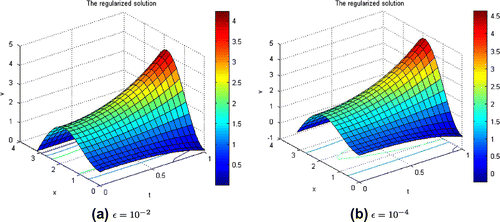
Figure 2. The exact solution (Equation47(47)
(47) ) for both two test functions in 3-D representation in Example 1.
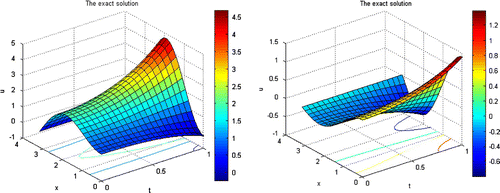
Figure 3. 2-D graphs of the exact solution (red) and regularized solution (green) at for
and
with
in Example 1.
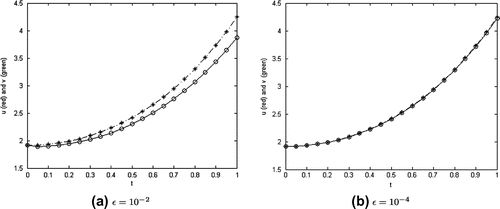
Figure 4. The regularized solution (Equation49(49)
(49) ) of Example 1 for
and
with
in 3-D representation.
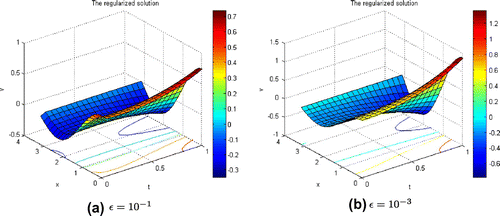
4.2. Comments
In these computations, the square grid size for time and space variables are set by choosing . The truncation term is simply equal to
. (Figure ).
Tables and show the absolute error at the midpoint and RRMS error defined in (Equation43
(43)
(43) ) and (Equation44
(44)
(44) ) for both two test functions
. Particularly, the tables show the errors between the exact solution whose existence is ensured under the test function
, recall that in this example we let
and
, and the regularized solution (Equation49
(49)
(49) ) at the fixed time
indicating three basic stages of time, nearly initial–middle–final, are both considered. We observe that the further initial point, the slower the convergence speed and the smaller
, the smaller are the errors.
For the test function , we show the corresponding exact solution in Figure (left). Despite the same 3-D shape, it should be given attention to the colour bar of the regularized ones, especially the maximum values attaining on the bar. In addition, Figure presents the 2-D graphs of the solutions at
for
. By observation, the regularized solution is close to the exact one when
gets smaller.
Similarly, for the test function , we show in Figure (right) the exact solution and in Figure the regularized solution (Equation49
(49)
(49) ) for
. In Figure , we present the 2-D graphs of the solutions at the middle point of space for
with
, respectively.
4.3. Example 2
In this example, we consider the Cauchy problem for an elliptic sine-Gordon equation:(57)
(57)
It is easy to see that for , we have an orthonormal eigenbasis
in
and
is the corresponding eigenvalue. The exact solution is
. Based on (Equation33
(33)
(33) ), we obtain the regularized solution:
(58)
(58) where
(59)
(59)
(60)
(60)
We compute from
from the following iterative scheme:
(61)
(61)
where(62)
(62)
(63)
(63)
We first split into three appropriate terms, a term
including
, a term
including the nonlinearity
and a term
containing the rest of this sum. In order to compute
and
, we apply Gauss-Legendre quadrature method (see [Citation19]). In particular, we have
(64)
(64)
(65)
(65)
where and
are abscissae in
and
, respectively, and
are associated weights.
We also do the same way in computing (Equation63(63)
(63) ). Hence, (Equation61
(61)
(61) ) can be determined.
Table 3. The absolute error (Equation43(43)
(43) ) and RRMS error (Equation44
(44)
(44) ) for
in Example 2.
Figure 6. The exact solution (left) and the regularized solution
(right) defined in (Equation58
(58)
(58) ) for
in 3-D representation in Example 2.
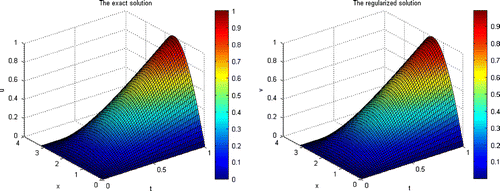
4.4. Comments
In these computations, the finer grid is used and the truncation term
is still fixed at
. As in Example 1, we show in Table the errors between the exact solution
and the regularized solution (Equation58
(58)
(58) ). In Figures and , 3-D and 2-D graphs of them are shown, respectively. In particular, we show in Figure the 2-D graphs describing how the regularized solution approaches the exact one when
becomes smaller and smaller for
to
. We also show the 3-D representation of the regularized solution (with
) in Figure (right).
From the numerical results, we can conclude that the further the initial guess, the slower the convergence. On the other hand, it can be probably observed that the errors reduce slowly when (
), and with a finer grid of resolution, we can have a better result in terms of smaller errors.
5. Conclusion
In this paper, we have studied a method to regularize the Cauchy problem for both linear and semi-linear elliptic equations which are severely ill-posed. Our approach is to present the solution of the problem in series representation, and then propose the regularized solution to control the strongly increasing coefficients appearing in the series. Under some prior assumptions, we deduce error estimates between the exact solution and regularized solution in Hilbert space norm. The convergence rate is established using logarithmic estimate. We apply fundamental tools, especially using contraction principle and Gronwall’s inequality, to prove these results (see more details in the Appendix 1).
In the numerical examples, we discussed semi-linear problems with the operator because of a wide range of applications. Thereby, we consider the linear modified Helmholtz equation and the elliptic nonlinear sine-Gordon equation. With lots of figures, tables and comments, our method is shown to be feasible and efficient. The code is written in MATLAB and the computations are done on a computer equipped with processor Pentium(R) Dual-Core CPU 2.30 GHz and having 3.0 GB total RAM.
The present paper gives some error estimates under a global Lipschitz case of source term . This makes the applicability of the method quite narrow. In future, we will consider the regularized problem in the locally Lipschitz case of the source function
.
Acknowledgements
The authors would like to thank the anonymous referees for their valuable suggestions and comments leading to the improvement of our manuscript.
Notes
This work is supported by HCMC University of Science under grant T2014-1 and Vietnam National University Ho Chi Minh City (VNU-HCM) under [grant number B2014-18-01].
References
- Reginska T, Reginski K. Approximate solution of a Cauchy problem for the Helmholtz equation. Inverse Probl. 2006;22:975–989.
- Bourgeois L, Darde J. A quasi-reversibility approach to solve the inverse obstacle problem. Inverse Probl. Imag. 2010;4:351–377.
- Hanke M, Hyvonen N, Reusswig S. Convex source support and its application to electric impedance tomography. SIAM J. Imag. Sci. 2008;1:364–378.
- Hadamard J. Lectures on Cauchys problem in linear partial differential equations. New York (NY): Dover; 1953.
- Hon YC, Wei T. Backus-Gilbert algorithm for the Cauchy problem of the Laplace equation. Inverse Probl. 2001;17:261–271.
- Elden L, Berntsson F, Reginska T. Wavelet and Fourier method for solving the sideways heat equation. SIAM J. Sci. Comput. 2000;21:2187–2205.
- Qian Z, Fu CL, Li Z-P. Two regularization methods for a Cauchy problem for the Laplace equation. J. Math. Anal. Appl. 2008;338:479–489.
- Tuan NH, Trong DD, Quan PH. A note on a Cauchy problem for the Laplace equation: Regularization and error estimates. Appl. Math. Comput. 2010;217:2913–2922.
- Hao DN, Duc NV, Lesnic D. A non-local boundary value problem method for the Cauchy problem for elliptic equations. Inverse Probl. 2009;25:055002.
- Hao DN, Lesnic D. The Cauchy problem for Laplace’s equation using the conjugate gradient method. IMA J. Appl. Math. 2000;65:199–217.
- Hao DN, Johansson T, Lesnic D, Hien PM. A variational method and approximations of a Cauchy problem for elliptic equations. J. Alg. Comput. Tech. 2010;4:89–119.
- Jourhmane M, Lesnic D, Mera NS. Relaxation procedures for an iterative algorithm for solving the Cauchy problem for the Laplace equation. Eng. Anal. Bound. Elem. 28:655–665.
- Marin L, Hao DN, Lesnic D. Conjugate gradient-boundary element method for the Cauchy problem in linear elasticity. Quar. J. Mech. Appl. Math. 2002;55:227–247.
- Gutshabash ES, Lipovskii VD. Boundary value problem for the two-dimensional elliptic sine-Gordon equation and its applications to the theory of the stationary Josephson effect. J. Math. Sci. 1994;68:197–201.
- Dang DT, Nguyen HT. Regularization and error estimate for the nonlinear backward heat problem using a method of integral equation. Nonlinear Anal. 2009;71:4167–4176.
- Lattés R, Lions JL. Methode de Quasi-reversibilite et Applications [The method of Quasi-reversibility applications to partial differential equations]. Paris: Dunod; 1967.
- Kirsch A. An introduction to the mathematical theory of inverse problems. Berlin: Springer-Verlag; 1996.
- Qian Z, Fu CL. Regularization strategies for a two-dimensional inverse heat conduction problem. Inverse Probl. 2007;23:1053–1068.
- Press WH, Flannery BP, Teukolsky SA, Vetterling WT. Numerical recipes in Fortran 90. 2nd ed. New York (NY): Cambridge University Press; 1996.
Appendix 1
In the appendix, we would like to present the proof of all theoretical results showed in Sections 2 and 3. On account of the proof of theorems intentionally divided into results of related lemmas, we will show the proofs of all lemmas first, then the results of theorems will become obvious to be concluded.
Proof of Lemma 1
From (Equation16(16)
(16) ) to (Equation17
(17)
(17) ), we have
(A1)
(A1)
By using the inequality , we get
(A2)
(A2)
Since and
, it yields
(A3)
(A3)
Applying (Equation3(3)
(3) ) to this, we obtain the desired result.
Proof of Lemma 2
By taking the derivative of in (Equation8
(8)
(8) ) with respect to
, we obtain
(A4)
(A4)
It follows from (Equation8(8)
(8) ) and (EquationA4
(A4)
(A4) ) that
(A5)
(A5)
We subtract from
to obtain
(A6)
(A6)
Finally, we obtain(A7)
(A7)
In the next step, to get the result, we have two cases.
| (1) | For | ||||
| (2) | For | ||||
Proof of Lemma 3
We now rewrite the difference between and
.
(A9)
(A9)
We note that , then it follows
(A10)
(A10)
Thus, (EquationA9(A9)
(A9) ) becomes
(A11)
(A11)
On the other hand, we have(A12)
(A12)
From (EquationA11(A11)
(A11) ) to (EquationA12
(A12)
(A12) ), as in proof of Lemma 2, we will consider two cases.
| (1) | For | ||||
| (2) | For | ||||
Proof of Lemma 4
In this proof, we also obtain the estimate (Equation27(27)
(27) ) under condition (Equation22
(22)
(22) ) by rewriting the difference between
and
, as
(A16)
(A16)
and using a simple inequality .
Proof of Lemma 5
The estimates (Equation38(38)
(38) ) and (Equation39
(39)
(39) ) are obvious under the inequality
. Indeed, from (Equation36
(36)
(36) ) we have
(A17)
(A17)
(A18)
(A18)
Therefore, the proof is completed.
Proof of Lemma 6
For , we consider the following function:
(A19)
(A19)
By defining(A20)
(A20)
becomes
(A21)
(A21)
We claim that, for every and
, we have
(A22)
(A22)
where is supremum norm in
. We shall prove this inequality by induction. Indeed, for
, we get the following estimate.
(A23)
(A23)
Using the following estimate(A24)
(A24)
we thus have(A25)
(A25)
Thus, (EquationA22(A22)
(A22) ) holds for
. Next, suppose that (EquationA22
(A22)
(A22) ) holds for
, we prove that (EquationA22
(A22)
(A22) ) also holds for
. We have
(A26)
(A26)
Therefore, by the induction principle, we obtain(A27)
(A27)
for all .
We consider and observe that
Thus, there exists a positive integer number such that
and is a contraction indicating the equation
has a unique solution
. Moreover, the fact is that
, then
. By the uniqueness of the fixed point of
, the equation
has a unique solution in
.
Hence, we obtain the result of this lemma.
Proof of Lemma 7
From (Equation33(33)
(33) ) and (Equation40
(40)
(40) ), it is clear that
(A28)
(A28)
Now we put(A29)
(A29)
(A30)
(A30)
(A31)
(A31)
We shall estimate these terms as follows. First, by (Equation35(35)
(35) ) and (Equation38
(38)
(38) ),
can be estimated as
(A32)
(A32)
Second, we apply (Equation35(35)
(35) ) and use the inequality
to obtain the estimate of
as
(A33)
(A33)
Finally, since (Equation39(39)
(39) ), we get the estimate of
as
(A34)
(A34)
It follows from (EquationA28(A28)
(A28) ) and (EquationA32
(A32)
(A32) )–(EquationA34
(A34)
(A34) ) that
(A35)
(A35)
Because of the fact that(A36)
(A36)
we continue to get from (EquationA35(A35)
(A35) ) that
(A37)
(A37)
Multiplying both sides of (EquationA37(A37)
(A37) ) by
, it yields
By using Gronwall’s inequality, we thus obtain(A38)
(A38)
which gives the desired result (Equation41(41)
(41) ).
By taking the derivative of in (Equation9
(9)
(9) ) with respect to
, we have
(A39)
(A39)
It follows that(A40)
(A40)
Let us return to the formula of in (Equation40
(40)
(40) ), then subtracting
from
, using (EquationA40
(A40)
(A40) ) and performing direct computation yield
(A41)
(A41)
We thus have(A42)
(A42)
Now we put as
(A43)
(A43)
(A44)
(A44)
Next, we shall estimate these terms (EquationA43(A43)
(A43) ) and (EquationA44
(A44)
(A44) ) as follows:
(A45)
(A45)
(A46)
(A46)
Combining (EquationA42(A42)
(A42) ) and (EquationA45
(A45)
(A45) )–(EquationA46
(A46)
(A46) ), we have
(A47)
(A47)
where is defined as in (Equation32
(32)
(32) ). Multiplying both sides of (EquationA47
(A47)
(A47) ) by
, it yields
(A48)
(A48)
Applying Gronwall’s inequality to (EquationA48(A48)
(A48) ), we conclude that
(A49)
(A49)
which implies the estimate (Equation42(42)
(42) ).
Proofs of Theorem 1 and 2
Substituting into the estimates of Lemmas 1–4 and using the triangle inequality, it is straightforward to conclude the whole desired results of Theorem 1. Similarly, substituting
into the estimates of Lemmas 5 and 7 and using the triangle inequality yield the estimate (Equation34
(34)
(34) ). Moreover, the uniqueness result in Lemma 6 implies the uniqueness of
mentioned in Theorem 2.

